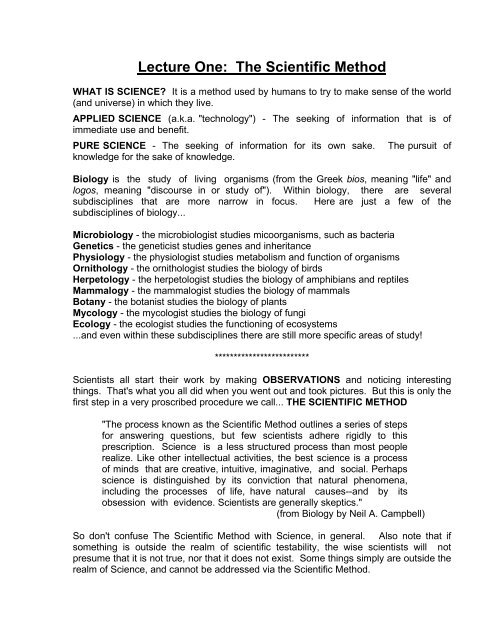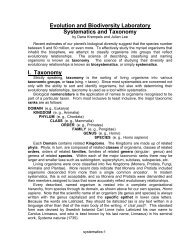Lecture One: The Scientific Method
Lecture One: The Scientific Method
Lecture One: The Scientific Method
You also want an ePaper? Increase the reach of your titles
YUMPU automatically turns print PDFs into web optimized ePapers that Google loves.
<strong>Lecture</strong> <strong>One</strong>: <strong>The</strong> <strong>Scientific</strong> <strong>Method</strong>WHAT IS SCIENCE? It is a method used by humans to try to make sense of the world(and universe) in which they live.APPLIED SCIENCE (a.k.a. "technology") - <strong>The</strong> seeking of information that is ofimmediate use and benefit.PURE SCIENCE - <strong>The</strong> seeking of information for its own sake.knowledge for the sake of knowledge.<strong>The</strong> pursuit ofBiology is the study of living organisms (from the Greek bios, meaning "life" andlogos, meaning "discourse in or study of"). Within biology, there are severalsubdisciplines that are more narrow in focus. Here are just a few of thesubdisciplines of biology...Microbiology - the microbiologist studies micoorganisms, such as bacteriaGenetics - the geneticist studies genes and inheritancePhysiology - the physiologist studies metabolism and function of organismsOrnithology - the ornithologist studies the biology of birdsHerpetology - the herpetologist studies the biology of amphibians and reptilesMammalogy - the mammalogist studies the biology of mammalsBotany - the botanist studies the biology of plantsMycology - the mycologist studies the biology of fungiEcology - the ecologist studies the functioning of ecosystems...and even within these subdisciplines there are still more specific areas of study!*************************Scientists all start their work by making OBSERVATIONS and noticing interestingthings. That's what you all did when you went out and took pictures. But this is only thefirst step in a very proscribed procedure we call... THE SCIENTIFIC METHOD"<strong>The</strong> process known as the <strong>Scientific</strong> <strong>Method</strong> outlines a series of stepsfor answering questions, but few scientists adhere rigidly to thisprescription. Science is a less structured process than most peoplerealize. Like other intellectual activities, the best science is a processof minds that are creative, intuitive, imaginative, and social. Perhapsscience is distinguished by its conviction that natural phenomena,including the processes of life, have natural causes--and by itsobsession with evidence. Scientists are generally skeptics."(from Biology by Neil A. Campbell)So don't confuse <strong>The</strong> <strong>Scientific</strong> <strong>Method</strong> with Science, in general. Also note that ifsomething is outside the realm of scientific testability, the wise scientists will notpresume that it is not true, nor that it does not exist. Some things simply are outside therealm of Science, and cannot be addressed via the <strong>Scientific</strong> <strong>Method</strong>.
DEDUCTIVE REASONING: From the general case to the specific(All birds have feathered wings. We know that sparrows have feathered wings.<strong>The</strong>refore, we can deduce that "Sparrows are birds.")INDUCTIVE REASONING: From a specific case to the general principle.(Sparrows are birds. <strong>The</strong>y have wings, and can fly. Robins, flamingos, owls, andeagles are birds, have wings and can fly. From this you might induce that "ALL BIRDSCAN FLY.")<strong>The</strong> problem with the latter is the "inductive leap": When you make the jump from manyobservations to saying that your observation is true in all cases, you are making ageneralization that might not be correct every time.Although generalizations can be useful, the wise scientist is always aware that theremay be EXCEPTIONS to the general rule, and to the possibility that the "general rule"might eventually be found to be wrong.Let's take the example above. You suddenly come upon an ostrich. It has wings, andall the other characteristics you'd ascribe to a bird--BUT IT CANNOT FLY! Does thismean that your general rule is always wrong? No. But it does mean that there areexceptions, and you must be ready to find them! <strong>The</strong> human mind is creative in itsinductive reasoning, but it is not omniscient (all-knowing) or infallible! This is whyscientists use deductive reasoning in their scientific endeavors. Such reasoning is lesssusceptible to this type of error.A common theme in scientific endeavors is the use of HYPOTHETICO-DEDUCTIVEREASONING: <strong>The</strong> formulation of an hypothesis (a tentative answer to a question) andthe execution of experiments from which one may deduce a general answer to thehypothesis. <strong>The</strong> steps in this process include:1. Observation2. Asking a critical question3. Developing a Hypothesis4. Making a prediction that can be tested5. Performing experiments to test the prediction6. Collecting and analyzing data7. Making a logical conclusion based on experimental resultsEXAMPLE:1. OBSERVATION: Flamingos eat a variety of invertebrates that they strain from thesilt. Interestingly, flamingo feather color is similar to that of the shrimps they eat.2. CRITICAL QUESTION: Is the color of the flamingo related to the color of the shrimpin their diet?3. DEVELOP HYPOTHESIS: Flamingo color is derived from shrimp pigments.a. Null Hypothesis: <strong>The</strong>re will be no significant difference in feather color betweengroups of flamingos fed different diets.b. Alternate Hypothesis <strong>The</strong>re will be a significant difference in feather colorbetween groups of flamingos fed different diets.4. MAKE PREDICTION: If flamingo diet is changed, its feather color will change.
5. PERFORM EXPERIMENTS:a. <strong>One</strong> group of flamingos gets a diet consisting of all items, including shrimp.(Control – sometimes abbreviated as "con")b. Other group of flamingos gets the same amount and type of food, but withoutshrimp. (Treatment – sometimes abbreviated as "trt")All other variables (habitat, light period, amount of food, etc.) are held CONSTANT inboth groups.6. COLLECT AND ANALYZE DATA:a. Possible result #1: No difference in color between trt and con groups.b. Possible result #2: Significant difference in color between trt and con groups.7. CONCLUSION:a. If you get result #1, then the null hypothesis cannot be rejected.b. If you get result #2, the null hypothesis is rejected, and the alternative hypothesisis accepted.<strong>The</strong> results of your study may suggest further experiments. (What component of theshrimp is responsible for the color of the flamingo's feathers? How does theflamingo metabolize nutrients in the shrimp into pink pigments?)Important aspects of hypotheses...* A HYPOTHESIS is a TENTATIVE EXPLANATION of a phenomenon.* A prediction is based on past experience about the phenomenon. It's an "educatedguess" about what you expect to happen.* Multiple hypotheses make good science. (If you have only one possible answer, youmay bias your experiment and your analysis.)* Hypotheses should be testable via experimental procedures or field studies based onthe hypothetico-deductive approach.* A hypotheses can be refuted (proven wrong, or FALSIFIED), but it CANNOT BEPROVEN CORRECT. (It is impossible to perform enough experiments to be certainthat the answer will always be the same, and that the same explanation will holdtrue.) However, if a hypothesis is tested again and again and is never falsified, itmay become elevated to the level of a THEORY.A word about the THEORY...A THEORY is an hypothesis that has stood the test of time. It is a well-substantiatedexplanation of some aspect of the natural world. It is an organized system of acceptedknowledge that applies in a variety of circumstances to explain a specific set ofphenomena. A theory is constantly subject to testing, modification, and refutation asnew evidence and ideas emerge.<strong>The</strong>ories also have predictive capabilities that guide further investigation.Example: <strong>The</strong> <strong>The</strong>ory of evolution by means of natural selection.And the LAW...A LAW is described by a sequence of events in nature that has been observed tooccur without variation under the same conditions. Natural law is the basis of theexperimental method in science, and is dependent upon cause and effect.Example: <strong>The</strong> Laws of <strong>The</strong>rmodynamics
THE MYSTERY OF THE GLASS FROGS: A slide show and exercise.We will now view a slide show about Glass Frogs (Centrolenella spp.) in Costa Rica,and try to develop some hypotheses about the evolutionary significance of the male'sbehavior when it comes to protecting his eggs.*********And on to today's activity, a Collage of Hypotheses (see Activity Sheet for instructions)Now that you are experts on how to ask critical questions, take your photos fromyesterday and ask questions about the phenomena you observed in the field. BESURE TO PHRASE THEM IN SUCH A WAY THAT YOU CAN CONSTRUCT A NULLAND ALTERNATE HYPOTHESIS, MAKE A PREDICTION, AND DESIGNEXPERIMENTS TO TEST THEM!

















